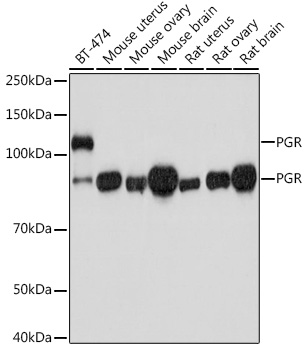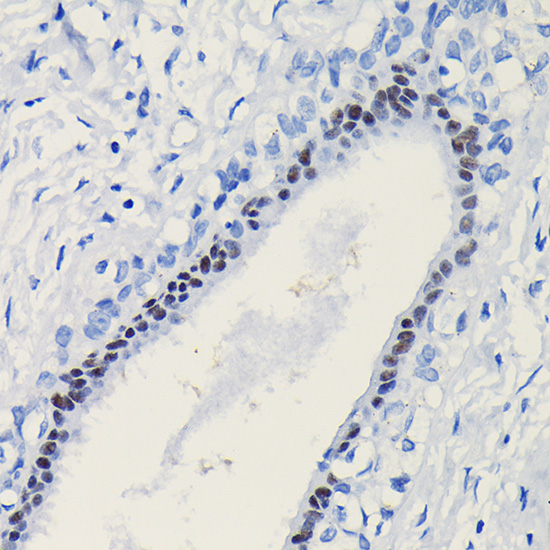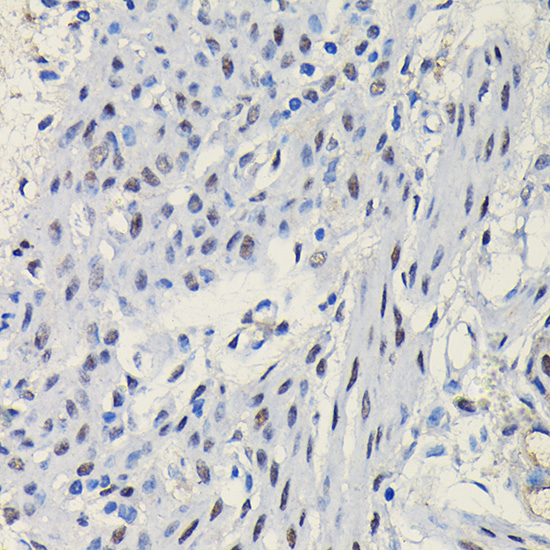Anti-PGR Antibody (CAB0321)
- SKU:
- CAB0321
- Product type:
- Antibody
- Reactivity:
- Human
- Reactivity:
- Mouse
- Reactivity:
- Rat
- Host Species:
- Rabbit
- Isotype:
- IgG
- Antibody Type:
- Polyclonal Antibody
- Research Area:
- Epigenetics and Nuclear Signaling
Description
| 抗体名: | Anti-PGR Antibody |
| 抗体コード: | CAB0321 |
| 抗体サイズ: | 20uL, 50uL, 100uL |
| 申し込み: | WB IHC |
| 反応性: | Human, Mouse, Rat |
| 宿主種: | Rabbit |
| 免疫原: | Recombinant fusion protein containing a sequence corresponding to amino acids 1-250 of human PGR (NP_000917.3). |
| 申し込み: | WB IHC |
| 推奨希釈: | WB 1:500 - 1:2000 IHC 1:50 - 1:100 |
| 反応性: | Human, Mouse, Rat |
| ポジティブサンプル: | BT-474, Mouse uterus, Mouse ovary, Mouse brain, Rat uterus, Rat ovary, Rat brain |
| 免疫原: | Recombinant fusion protein containing a sequence corresponding to amino acids 1-250 of human PGR (NP_000917.3). |
| 精製方法: | Affinity purification |
| ストレージバッファ: | Store at -20'C. Avoid freeze / thaw cycles. Buffer: PBS with 0.02% sodium azide, 50% glycerol, pH7.3. |
| アイソタイプ: | IgG |
| 順序: | MTEL KAKG PRAP HVAG GPPS PEVG SPLL CRPA AGPF PGSQ TSDT LPEV SAIP ISLD GLLF PRPC QGQD PSDE KTQD QQSL SDVE GAYS RAEA TRGA GGSS SSPP EKDS GLLD SVLD TLLA PSGP GQSQ PSPP ACEV TSSW CLFG PELP EDPP AAPA TQRV LSPL MSRS GCKV GDSS GTAA AHKV LPRG LSPA RQLL LPAS ESPH WSGA PVKP SPQA AAVE VEEE DGSE SEES AGPL LKGK PRAL GGAA AG |
| 遺伝子ID: | 5241 |
| Uniprot: | P06401 |
| セルラーロケーション: | Cytoplasm, Cytoplasm, Mitochondrion outer membrane, Nucleus |
| 計算された分子量: | 36kDa/38kDa/82kDa/87kDa/98kDa |
| 観察された分子量: | 90KDa/118KDa |
| 同義語: | NR3C3, PR, PGR |
| バックグラウンド: | This gene encodes a member of the steroid receptor superfamily. The encoded protein mediates the physiological effects of progesterone, which plays a central role in reproductive events associated with the establishment and maintenance of pregnancy. This gene uses two distinct promotors and translation start sites in the first exon to produce several transcript variants, both protein coding and non-protein coding. Two of the isoforms (A and B) are identical except for an additional 165 amino acids found in the N-terminus of isoform B and mediate their own response genes and physiologic effects with little overlap. |
| UniProt Protein Function: | Function: The steroid hormones and their receptors are involved in the regulation of eukaryotic gene expression and affect cellular proliferation and differentiation in target tissues. Progesterone receptor isoform B (PRB) is involved activation of c-SRC/MAPK signaling on hormone stimulation. Ref.12 Ref.20 Ref.21 Ref.23 Ref.24 Ref.25 Ref.26 Ref.27Isoform A:inactive in stimulating c-Src/MAPK signaling on hormone stimulation. Ref.12 Ref.20 Ref.21 Ref.23 Ref.24 Ref.25 Ref.26 Ref.27Isoform 4:Increases mitochondrial membrane potential and cellular respiration upon stimulation by progesterone. Ref.12 Ref.20 Ref.21 Ref.23 Ref.24 Ref.25 Ref.26 Ref.27 |
| UniProt Protein Details: | Subunit structure: Interacts with SMARD1 and UNC45A. Interacts with CUEDC2; the interaction promotes ubiquitination, decreases sumoylation, and repesses transcriptional activity. Interacts with PIAS3; the interaction promotes sumoylation of PR in a hormone-dependent manner, inhibits DNA-binding, and alters nuclear export. Interacts with SP1; the interaction requires ligand-induced phosphorylation on Ser-345 by ERK1/2 MAPK. Interacts with PRMT2. Ref.18 Ref.19 Ref.22 Ref.23 Ref.24 Ref.27 Subcellular location: Nucleus. Cytoplasm. Note: Nucleoplasmic shuttling is both homone- and cell cycle-dependent. On hormone stimulation, retained in the cytoplasm in the G1 and G2/M phases. Ref.12 Ref.20 Ref.21 Ref.26Isoform A: Nucleus. Cytoplasm. Note: Mainly nuclear. Ref.12 Ref.20 Ref.21 Ref.26Isoform 4: Mitochondrion outer membrane Ref.12 Ref.20 Ref.21 Ref.26. Domain: Composed of three domains: a modulating N-terminal domain, a DNA-binding domain and a C-terminal ligand-binding domain. Post-translational modification: Phosphorylated on multiple serine sites. Several of these sites are hormone-dependent. Phosphorylation on Ser-294 occurs preferentially on isoform B, is highly hormone-dependent and modulates ubiquitination and sumoylation on Lys-388. Phosphorylation on Ser-102 and Ser-345 also requires induction by hormone. Basal phosphorylation on Ser-81, Ser-162, Ser-190 and Ser-400 is increased in response to progesterone and can be phosphorylated in vitro by the CDK2-A1 complex. Increased levels of phosphorylation on Ser-400 also in the presence of EGF, heregulin, IGF, PMA and FBS. Phosphorylation at this site by CDK2 is ligand-independent, and increases nuclear translocation and transcriptional activity. Phosphorylation at Ser-162 and Ser-294, but not at Ser-190, is impaired during the G2/M phase of the cell cycle. Phosphorylation on Ser-345 by ERK1/2 MAPK is required for interaction with SP1. Ref.11 Ref.13 Ref.14 Ref.15 Ref.16 Ref.17 Ref.20 Ref.21 Ref.25 Ref.26 Ref.27Sumoylation is hormone-dependent and represses transcriptional activity. Sumoylation on all three sites is enhanced by PIAS3. Desumoylated by SENP1. Sumoylation on Lys-388, the main site of sumoylation, is repressed by ubiquitination on the same site, and modulated by phosphorylation at Ser-294. Ref.23 Ref.24 Ref.25Ubiquitination is hormone-dependent and represses sumoylation on the same site. Promoted by MAPK-mediated phosphorylation on Ser-294. Ref.23 Ref.24 Ref.25Palmitoylated by ZDHHC7 and ZDHHC21. Palmitoylation is required for plasma membrane targeting and for rapid intracellular signaling via ERK and AKT kinases and cAMP generation. Ref.28 Sequence similarities: Belongs to the nuclear hormone receptor family. NR3 subfamily.Contains 1 nuclear receptor DNA-binding domain. |
| NCBI Summary: | This gene encodes a member of the steroid receptor superfamily. The encoded protein mediates the physiological effects of progesterone, which plays a central role in reproductive events associated with the establishment and maintenance of pregnancy. This gene uses two distinct promotors and translation start sites in the first exon to produce two isoforms, A and B. The two isoforms are identical except for the additional 165 amino acids found in the N-terminus of isoform B and mediate their own response genes and physiologic effects with little overlap. [provided by RefSeq, Jan 2011] |
| UniProt Code: | P06401 |
| NCBI GenInfo Identifier: | 90110048 |
| NCBI Gene ID: | 5241 |
| NCBI Accession: | P06401.4 |
| UniProt Secondary Accession: | P06401,Q8TDS3, Q9UPF7, A7LQ08, A7X8B0, B4E3T0, |
| UniProt Related Accession: | P06401 |
| Molecular Weight: | |
| NCBI Full Name: | Progesterone receptor |
| NCBI Synonym Full Names: | progesterone receptor |
| NCBI Official Symbol: | PGR |
| NCBI Official Synonym Symbols: | PR; NR3C3 |
| NCBI Protein Information: | progesterone receptor; nuclear receptor subfamily 3 group C member 3 |
| UniProt Protein Name: | Progesterone receptor |
| UniProt Synonym Protein Names: | Nuclear receptor subfamily 3 group C member 3 |
| Protein Family: | Perakine reductase |
| UniProt Gene Name: | PGR |
| UniProt Entry Name: | PRGR_HUMAN |





